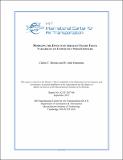Modeling the Effects of Aircraft Flight Track Variability on Community Noise Exposure
Author(s)
Brooks, Callen; Hansman, R. John
DownloadBrooks_Thesis_ICAT_Report.pdf (99.95Mb)
Metadata
Show full item recordAbstract
The implementation of Performance Based Navigation (PBN) routes across the National Airspace System (NAS) has caused a significant concentration of flight tracks. This flight track concentration also creates a concentration of noise impacts on the communities surrounding airports, which has led to an increase in noise complaints at many airports that have implemented these routes. In order to understand these changes in noise, and to design procedures that could help mitigate any negative effects, it is important to have modeling tools capable of capturing the noise impacts of flight track variability. This thesis develops a model for this purpose. First, twenty days of radar flight trajectory data from 2015 and 2016 at Boston Logan International Airport (KBOS) is used to quantify the observed distributions of variability in speed, altitude, and lateral track position. It is shown that altitude and speed variability have relatively small impacts on noise, but that the impacts of observed lateral variability are significant. Using this information, a physics-based model is developed to capture the noise impacts of lateral flight track variability. This tool is then used to model several example scenarios. First, the changes in noise due to pre- and post-PBN procedures are examined for KBOS Runway 33L departures. Next, a hypothetical procedure is designed to intentionally introduce lateral dispersion to KBOS Runway 33L departures. Finally, the tool is used to rapidly model noise impacts on due to both arrival and departure operations on all runways at KBOS. The model is shown to reduce computational expense by 1-2 order of magnitude relative to traditional methods. The results of these example analyses show that increased lateral dispersion causes a significant noise reduction at higher noise levels directly below the flight track at the cost of wider contours at lower noise levels. Because of this, any decision to add or remove flight track lateral dispersion has highly localized impacts that depend on the geometry of the route and the population of the surrounding area, and thus must be closely analyzed on an individual basis.
Date issued
2017-07-20Series/Report no.
ICAT;2017-06
Keywords
Aircraft noise, Noise modeling, Dispersion, AEDT, Air Transportation